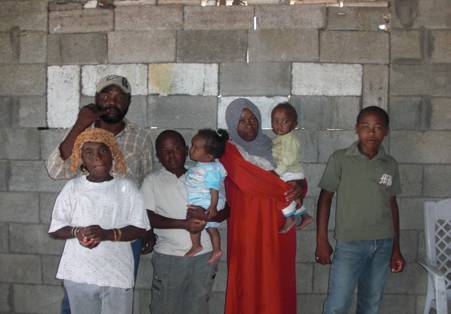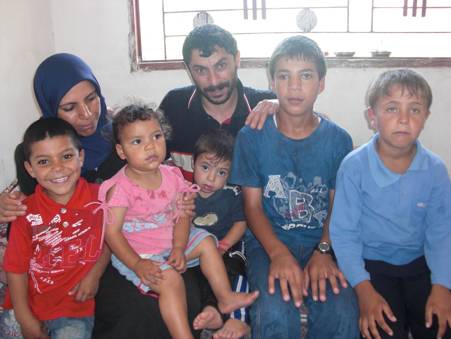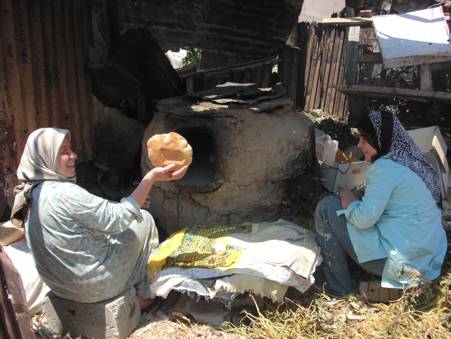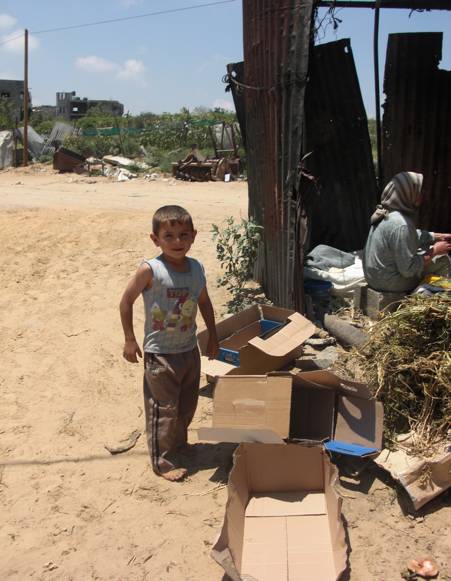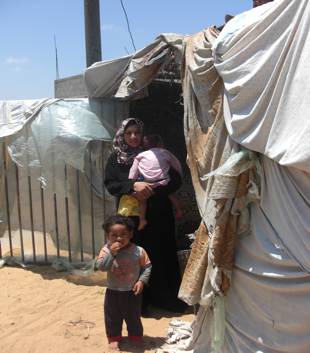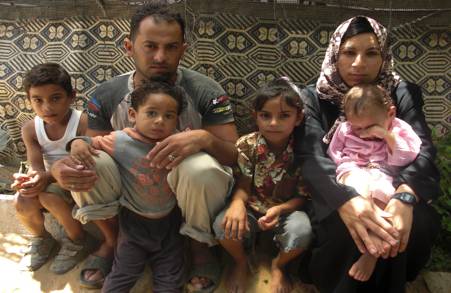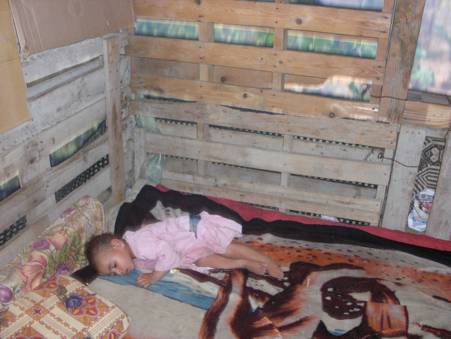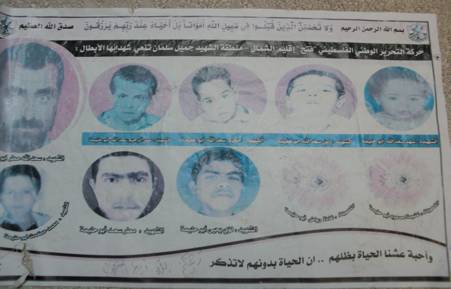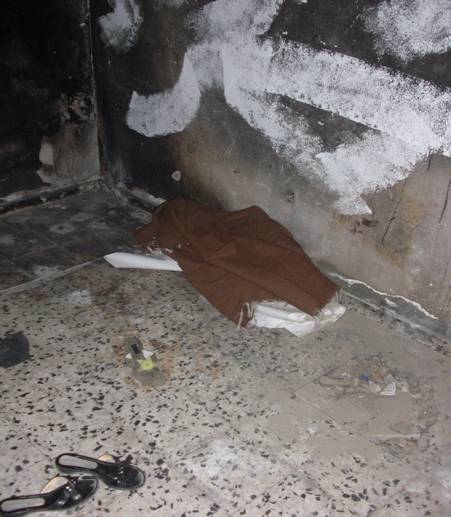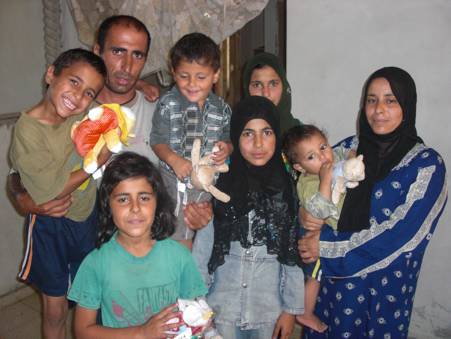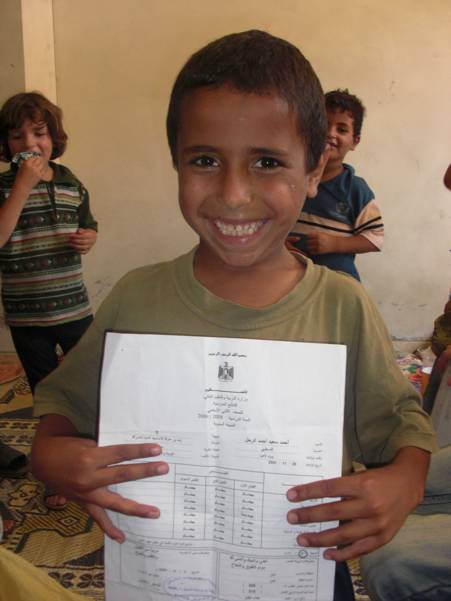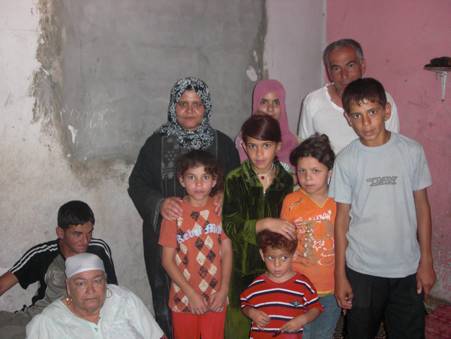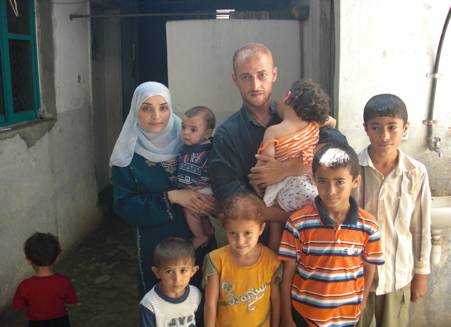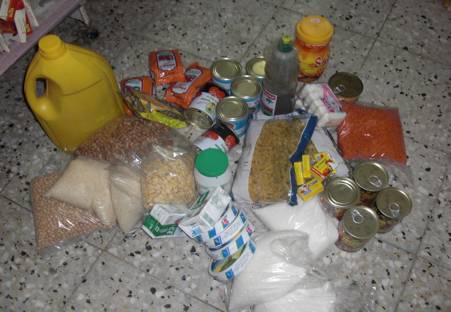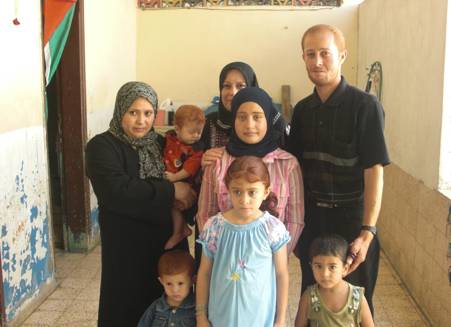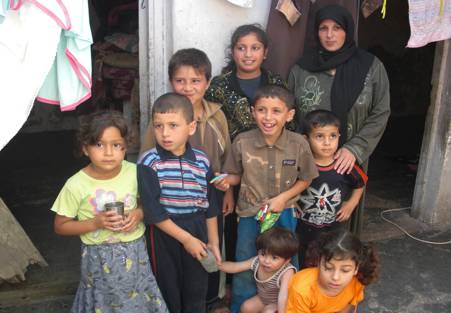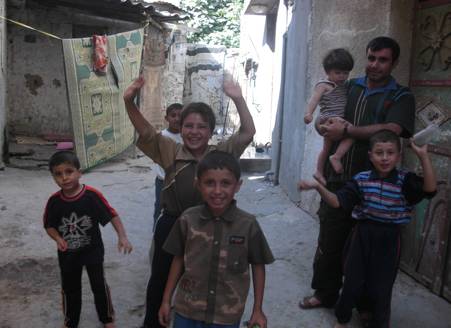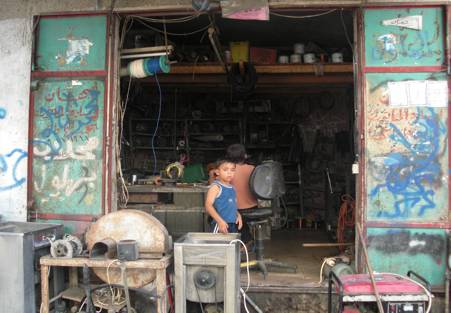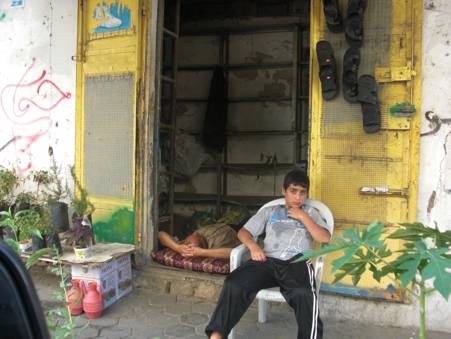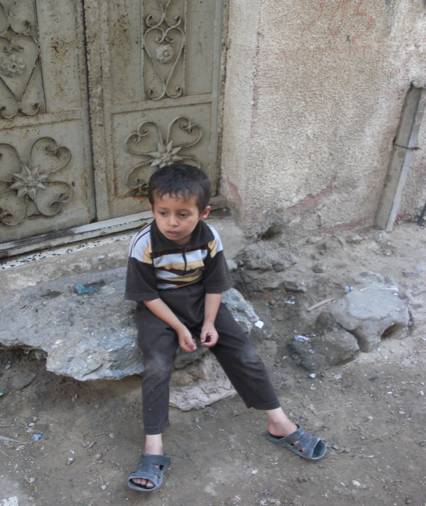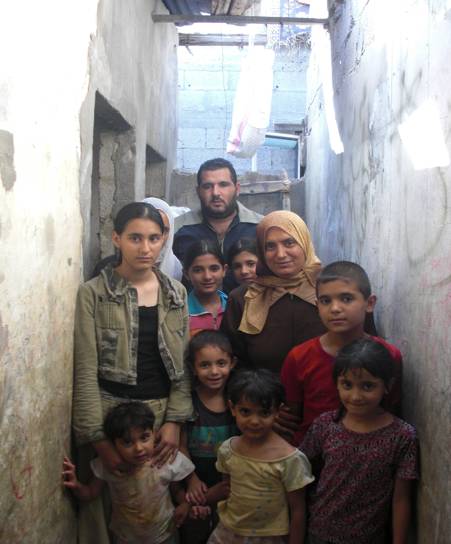


Tuesday’s Child Blog Tuesday’s Child Returns to Gaza – Day 2 Tuesday 7th July 2009 We set off today at 9 a.m. Our first stop is to a confectioner to buy sweets for children. The choice is much more limited here than in the Arab quarter of Israel but important to support local businesses and they are very glad for the custom. We make up 4 large bags of pick and mix before setting off to Northern Gaza. We have selected 10 families from this area (area 1 of the food distribution programme), 9 at random and one by request, the family of Dima, the little girl I met in Cairo in February, who died from her injuries in March. The heat is already a blistering 41 degrees. Our first stop is with 3 families in Beit Lahyia. The first of these a Bedouin family, Mesleh Farahan, living in very poor conditions, with 7 children including 2 babies to feed. We listen to their story, they give thanks that they are all alive and the food they receive from the programme. The only source of dried milk is via the tunnels and it is expensive at 26 shekels a tin, so two hungry babies eat considerably into the family allocation of 200 shekels per month. We give them money for milk and fruit for the year and the mother of the family weeps with gratitude. I think of the waste at home and the things we buy that we don’t need and it is very humbling. The Farahan family were previously living in the middle area Deil Belah and their home was demolished before the war. They moved to Northern Gaza as they have relatives in this area. As with many families in Gaza, it is wave of trauma after trauma and I wonder how they can keep going.
The second family here in Beit Lahyia is Ahmed El Atar who lost their home in the war. We walk upstairs to a small area of three rooms, the main area with a couch at one end. On it sits the father of the family, Ahmed, and I can immediately see he has no legs. He introduces me to his wife and 5 children and after introductions I sit on the mattress beside him and listen to his story. Pain and despair are etched into this young man’s face, as he tells his story and it is clearly emotionally difficult for him to talk about it. He looks very much older than his 28 years. “I was visiting my brother to see how he was doing and to ask him to come to our home to stay with us and I heard the attack. It was crazy, there was noise of shelling all around and fighter planes were buzzing overhead. I was worried for my family so I sprinted back across the fields towards our home. One of the tanks spotted me and chased me and started firing. They hit me and cut me and that is the last thing I remember. My next memory is waking up in hospital and both my legs were gone. I spent a month in hospital in Turkey. The same day as I was wounded, we lost our home and my eldest son lost the sight in his right eye”. Ahmed lifts his sarong and shows me both of his stumps. I notice how high both amputations are, each to above the upper thigh. I sit with him as his children each come over to him to play. He thanks us for the feeding programme, it is one less worry for him that there is some food each month for his family on a regular basis. I ask about artificial limbs, he said he is waiting to be fitted with these. We give him money towards the family needs for the coming year and we leave him playing with his youngest child. Gaza has many amputees like Ahmed, this is just one of hundreds of similar stories. Who will help to rehabilitate Ahmed? There are no community care services in Gaza. Who will help him explain this war to his children?
Outside, the area of Beth Lahyia is almost obliterated. The living conditions are almost impossible, made worse by limited electricity, no running water and lack of refrigeration. There seem to be children everywhere. Two young women sit in a makeshift shack. As there is no electricity here, they are baking bread in a clay oven; the bread is for the whole neighbourhood. Despite the surrounding chaos, they seem in good spirits and are enjoying baking in the outdoors. They offer me some bread to taste. Children help the women bring cardboard to keep the oven alight. The community spirit is strong, people here, young and old, muck in and help each other out in the daily game of survival.
About 500 yards along, we stop with a third family. Again, both parents are in their late twenties with 5 children. We fed this family before the war as their home was demolished in 2007 and they had no means of income or support. We continue to do so as they have been badly affected by the war. Again, we are introduced and I sit to listen to their story, as the children politely help themselves to the sweets. Their father, Hassan, was lifted by Israeli soldiers and struck on the head, he fell and that is the last he can remember. Others saw his body lifted and thrown on the side of the street with many other bodies. Some time passed, he is not sure if it was hours or days, and he regained consciousness. He wakened and he describes the scene, “all around me there were dead bodies, covered in flies and the smell of rotting flesh and dogs eating the arms and legs and heads of the dead bodies. A woman noticed I was moving and called for help and an ambulance came and took me to hospital”. He has not slept well since and was later transferred to a psychiatric hospital where he spent some weeks. He continues to have the same recurring nightmare. Hasaan has since been diagnosed with schizophrenia. His wife shows me the hospital letter, the diagnosis and the medicines she now has to give him. While, everything is in Arabic, medical conditions and medicine names are standard around the world so it easy to understand the condition and the three tablets he is taking. The last house the father had gross physical trauma and now in this home, mental trauma. I know that post traumatic stress can trigger acute mental illness, however I was not aware schizophrenia was one of these. We leave extra money for food for the year with the mother. I ask if there is anything else she needs. She shows me the fingers and toes of her baby eaten by mice and the bite marks. I notice, as I look on the sleeping child, that she has rickets. I give her 3 months of food supplements for each of her children and explain to her how to give them. Human beings should not have to suffer like this.
We drive to visit our next family and just when I thought it could not get any worse, this family of 17 lost 8 people in one assault. I speak to two of the surviving sons. The house is still charred, all black on the walls. They have since painted two of the walls with white paint procured through the tunnels. As many families did, they were huddled in what is considered the safest part of the home at the end of the upstairs corridor. A white phosphorus bomb came through the roof of the home, just above where the family was gathered. The mother was breastfeeding her baby at the time. The son remembers everyone screaming and burning and the child’s screams from the white phosphorus the loudest. Six of the family burned to death and 2 cousins also killed. The mother survived and is in a psychiatric hospital; she also has burns to her arms, face and chest. Inside in the bedroom wall, Israeli soldiers have drawn a Star of David and slogans celebrating so many deaths in one hit. And Israel say this is not a war against civilians. Unlike, most families in Gaza, this family had some money and a relatively comfortable standard of living before December 2008. Operation Cast Lead shattered their lives. In addition to the murder of half of their family, they lost everything they owned and why they were prioritised for aid in February. The family had no political involvement. He shows me the spot where the family were killed and where the white phosphorus bomb came through the roof, it landed directly on top of them, as if the bomb pin-pointed the family. Shoes and charred possessions still lie in the corridor. As I stand in the spot where these 8 people died, the sheer horror of this war hits hard and looking at the faces of the dead in the poster on the wall, including the 8 month baby girl, it begs the question why? Tears trickle down my cheeks and I break Palestinian custom and embrace these two young men who are openly weeping. It really doesn’t get any worse than this and I wonder how they will manage to grow older without holding hatred towards those who committed this atrocity.
We move on to visit our next family, that of Said El Rahel. I met Siad in the Palestinian hospital in Cairo in February 2009. His 5 yr old daughter Dima, was in ICU there with a severe head injury from which she died a few weeks after our visit, the 313th child reported to die as a result of Operation Cast Lead. We included Siad, his wife and 6 remaining children to our feeding programme. The El Rahel family welcome us warmly and we give out, colouring pencils, toys and sweets to Dima’s brothers and sisters. Dima’s older sister who is 7yrs old, shows me the scars on her head after being hit in an air strike of one of the UN schools on 6th January 2009. She explains she still gets bad headaches and cannot remember things at times. Dima’s mother thanks us for the food and gives me a school picture of Dima. Her father, an onion farmer before the blockade, takes us upstairs to show the house next door where she was hit and points to where he found her some 30 metres away bleeding profusely with her brain exposed. “It was the two most terrible days of my life, two daughters badly injured within 24 hrs. I will never forget it. We all feel Dima’s loss greatly, what did my little daughter do to be killed like this? All the children are still very frightened, they are very nervous, the least noise and they jump. It is the same for all of us” says Siad.
There is a huge focus on education of children here in Gaza and yet failure rates in examinations have been high these last two years. However, it is difficult to learn when you are hungry and children throughout Gaza have found it particularly difficult to concentrate on studying long before this latest war. I ask the El Rahel children about school and if they like it and how they are doing. They tell me they love going to school and one by one they show me their school reports. I take photos and tell them I will send copies for them to put on the wall of their home. The children queue up to show me their school reports and grades.
We say good-bye to the El Rahel family and drive to Jabalyia refugee camp, more like a city than a camp with some 200,000 inhabitants. It is over-run by children and donkeys, hence it’s often known as the "city of the child and donkey" and one can see why many of both were killed here during the war. Our first stop here is with the Fathia Abed Rabo family, whom we have been feeding since November 2007 and whom we met in August 2008, on our first visit to the strip. They also featured in the film we made last year. It is great to see them all alive. Fathia proudly shows me her wheelchair supplied by the Daughters of Charity. They explain they evacuated to one of the UN schools when the war started, they left everything. The greatest challenge was moving their grandmother in the shelling. They thank God that they are alive. As with all families, we leave money for their needs and they are delighted. We have to move on as we have many families to visit. The next is the Hathem Mohra family, also in Jablayia, a family of 7 children. This family are new to the programme, joining it post-war. Hathem was lifted by Israeli troops and badly beaten. He is still suffers from severe pain in his back and leg and is unable to lift anything, even the children. As with most of our families, the living spaces are cramped and basic.
The living area is basically a yard with small outhouses of it. I ask how long the food lasts and they say about 10 days. It is not enough and seems to be the average duration for every family. However, these items cost an equivalent of £32 per month and this is difficult enough to raise at home in the current economic climate. Mrs Mohra explains that she is expecting another baby so soon there will be another mouth to feed and, as on many occasions today, she weeps when I give her money for her family to help with the months ahead. Their gratitude is deeply humbling. En route to the next home visit we stop at the supermarket in Jabalyia. I am keen to meet with the shopkeeper and see what families are getting currently for their monthly food coupon compared to this time last year. Also to see where exactly food is currently sourced post-war. While the food shops in each area are called supermarkets, they are really small grocery stores, with not unreasonable stock now, although many were empty during the war as all trucks into Gaza were refused for 2 months previous to it. The shop-assistant prepares a common monthly choice for a food coupon, based on necessity, not luxury. This comes to 214 shekels and they usually give 10 - 15 shekels discount. Families can choose items up to the coupon equivalent; the little choice gives dignity and we prefer this to standard food parcels. It is disappointing to note however that families are getting less per 200 shekel coupon than this time last year, but with internal prices rocketing, that is to be expected. Still, they are getting more than I thought possible and we estimate the drop in supplies is about 10 percent, 20 shekels.
A typical family choice for a monthly coupon would be as follows: butter 1 kg, olive oil 1L, sunflower oil 4L, lentils 1kg, beans 2kg, chickpeas 1 kg, rice 2kg, pasta 1kg, sugar 3 kg, tuna 2 tins, beef meat 4 tins, cheese 500 g, cheese triangles 4 packets, kidney beans 4 tins, stock cubes 5 boxes, tomato paste 250g x 2, salad dressing, coffee 250g, tea 500 g, yeast 1 packet, soap 10 bars. Bread is not usually taken as it is cheaper to make than buy and most people will try and make their own bread wherever possible. Cigarettes and other sundries are not permitted. Other families will buy sacks of flour or formula milk for babies. Food supplies into the supermarket come from: Egypt, West Bank, Israel and also via the tunnels. The food from Israel is very limited in choice and currently with a cutback in aid by over 80 percent, people in Gaza could not survive without the tunnels. I ask what different the tunnels make. “There are over 1400 tunnels into Gaza from Egypt”, says Ahmed, our driver, “if it was not for the tunnels we would die”. I buy some cans of 7UP for the team as it is very hot. I wonder are they in date as they are dented and dirty, with grains of dirt over them. And then I realise, these have come from the tunnels, the dirt is sand and I will discover, many items for sale in Gaza, are covered in the tunnel grit. We will visit the tunnels next week. I am approached by a man in the supermarket by the name of Sami. He is fluent in English and intimates that he is in partnership with the owner. He speaks at length of the food supplies and sources, and regular purchases of families. He seems very knowledgeable, affable and helpful. He offers his email and asks me for my contact details, email and phone number and I give him these. He even stops in the door of the supermarket to have his photograph taken. Later in the afternoon, I am told that Sami is not bonafide and represents an ugly and seedy undercurrent in Gaza, only out for their own gain. I think the observation a little paranoid until later tonight when I receive 3 texts and 3 voicemails from him. It is now 4 p.m and we drive on to visit the next family chosen at random to visit. This family also live in Jabalyia and have been part of our feeding programme since November 2007. Their father has cancer and the growth in this 31 yr old man’s face and it is clearly evident when he greets us. Yousif El Jarjeet is a father of 7 children and his sister also lives with him and his family. He explains the horrors of the war and the fear for their safety as they remained cocooned in their homes for days with no food and little water. “We stayed in this section of the house, for 15 days continuously", he explains, “without food, light, anything and the bombs continued to fall. I didn’t attend throughout the war for my chemotherapy, it was too dangerous”. He explains how the monthly food coupon has kept his family going even though it doesn’t last for more than 2 weeks but that is good to be able to rely on the core supply every month. Again, we give them enough money to help over the next 6 months and they are overjoyed. Just a short drive away we meet our next family, the Jomah family, mother of 8 and a baby on the way. To fathom where they are living is hard to describe. It is not a house, but the end of an entry, over the front of which they have run a curtain across. The first thing that hits you walking behind the curtain is a mountain of washing drying on washing lines that criss cross the whole area. Mrs Jomah shows us the damage to her “home” from the war. Like many, while still traumatised, they are just glad to be alive. She says the food we give lasts anything between 10 and 14 days; we give her money for more food for the months ahead and her eldest daughter is ecstatic, jumping up and down and clapping her hands. As with all families, they kindly offer us tea, but we have a busy schedule so decline. Mrs Jomah asks me if we can help with a doctor for her child’s right foot; this is a chronic muscle defect, congenital and probably correctable by surgery and I make a note to see if we can arrange a referral to a paediatrician. The Jomah family wave goodbye. Again, I could not live in such conditions and I admire their ability to.
Jabalyia, apart from being the most densely populated region, is undoubtedly the most colourful area in Gaza. Every doorway however tells a story, often one of human suffering, and yet the people here are trying to get on with things although many say they don’t have the heart and their spirit is broken. As we drive along and take pictures of street scenes, I wonder what story likes behind each cameo? I notice one little boy, sitting alone and just contemplating. He is the first child in Jabalyia I have seen wearing a pair of shoes. How did so many manage during the war with white phosphorus falling everywhere, in their bare feet? It is also the first time I have come across a child alone in Jabalyia as the law of the street here is that no child walks alone. I would like to hear more from the children and their experiences, but at the same time, one does not want to bring them back to the most horrific of nightmares from which they are trying to recover. Time to leave Jabalyia and drive North to make our last home visit of the day, to Beit Hanoun. As we drive across the area the smell of raw sewage is rancid, combined with the over 40 degree heat, overwhelming. The family here are the Sharfa-El-Massrey family with 11 children. They live in a narrow house no bigger than the back yard of an average terrace house at home. Mrs Sharfa El-Massrey shows me the damage from the bombings and the holes in the ceilings and roof. Her husband speaks of the war and the sheer terror of it, explaining the family are all still very stressed and tearful. For a month after the war, they could not sleep, they were too afraid to sleep as many neighbours died in their beds.
I ask how long the food coupon lasts and they say about 12 days. I give Sharfa money to support the family and she is thrilled. You would think this warm and friendly woman had just won the lotto! I notice the washing on the line and ask her how she manages to wash so many clothes for 13 people. She shows me her hands and laughing says they are ruined. I ask her if she has a washing machine. She says no but it would be like heaven to have a washing machine to use between the electricity curfews. It would also give her more time with the children. I promise her a washing machine, if we can source one, before I leave Gaza. We leave a very happy woman with just some of her burdens eased for now. Later she phones our aid co-ordinator, still ecstatic. She has never had this amount of money in her life before, yet we have given her 1000 shekels, about 250 dollars or 175 stg. I have spent more in a shopping afternoon and it underlines how uneven the world is between East and West. Time to return to the hotel now and I look forward to a shower, another luxury here, which we take for granted at home. It is 2 a.m. now and I am still writing about today. From starting at 8.30 p.m to now there have been 6 power failures. I find this, being used to light and air-conditioning at the flick of a switch, very frustrating. Time for bed and, as I pray to my guardian angel, I reflect on the day and all the families and broken lives I met and I think of the many dead and badly injured. Where were all of their guardian angels? Working overtime I decide. For it is clear today from the damage and mass obliteration of Beit Lahyia, Jabalyia and Beit Hanoun that this war could have killed thousands upon thousands of people. It is a miracle that the death toll was not much higher. I open the volume from direction for our times and read “All children of the earth, hear My call. You have sampled the world’s offerings and you have been left unloved and in darkness. I offer you all that is light and good. I offer you safety and confidence. I will nourish you in times of hunger and console you in sadness”. As I switch off the light, I ask Him to send me more money to help with the hunger and bring His healing balm all those suffering across Gaza tonight. Most of all, to bring an end to this most cruel blockade. If you are in a position to help any of the families we met during our time in Gaza, please contact us at info@tuesdayschild.co.uk or donate online here » |
||||
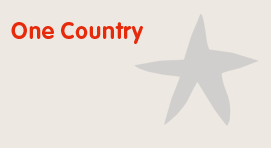 |
Country Spotlight: Democratic Republic of Congo... The recent civil war in eastern DRC has devastated many aspects of life and children are among those most affected. A population size equivalent to that of Ireland, north and south, died either through direct conflict or displacement. Mulongo is a school catering for about 2000 children. The school is one of many decimated during the war. It needs rebuilt and basic school supplies and a playground facility with better salaries to retain underpaid teachers. The Active Christian Evangelism (ACE) Group, lead by Dr Graham Fry, is funding the project; more funds are needed. Other areas in needs are feeding programmes, health promotion programmes and support of a new maternity hospital. Find out more about the Countries we help... |
Tel: +44 (0)289 050 2725 | Mobile: +44 (0) 7545 452362 | Email: info@tuesdayschild.org.uk | Terms
